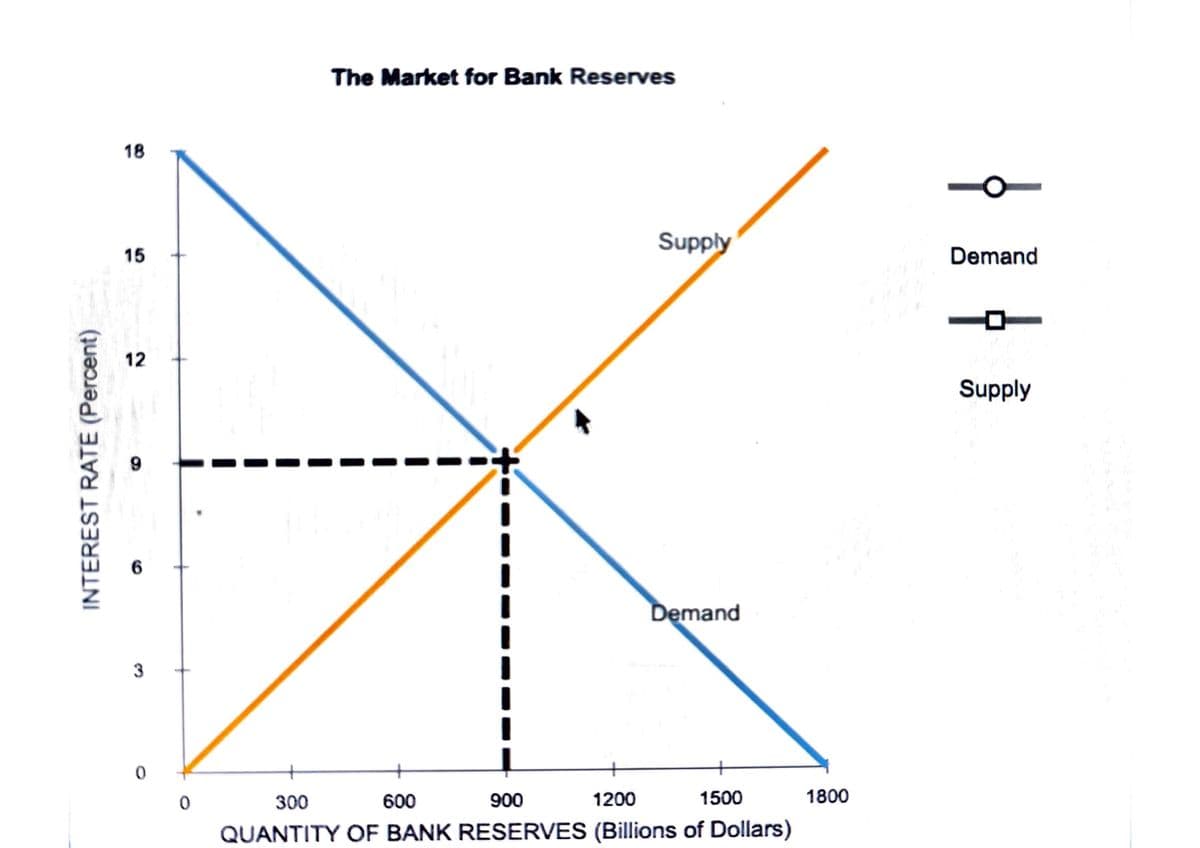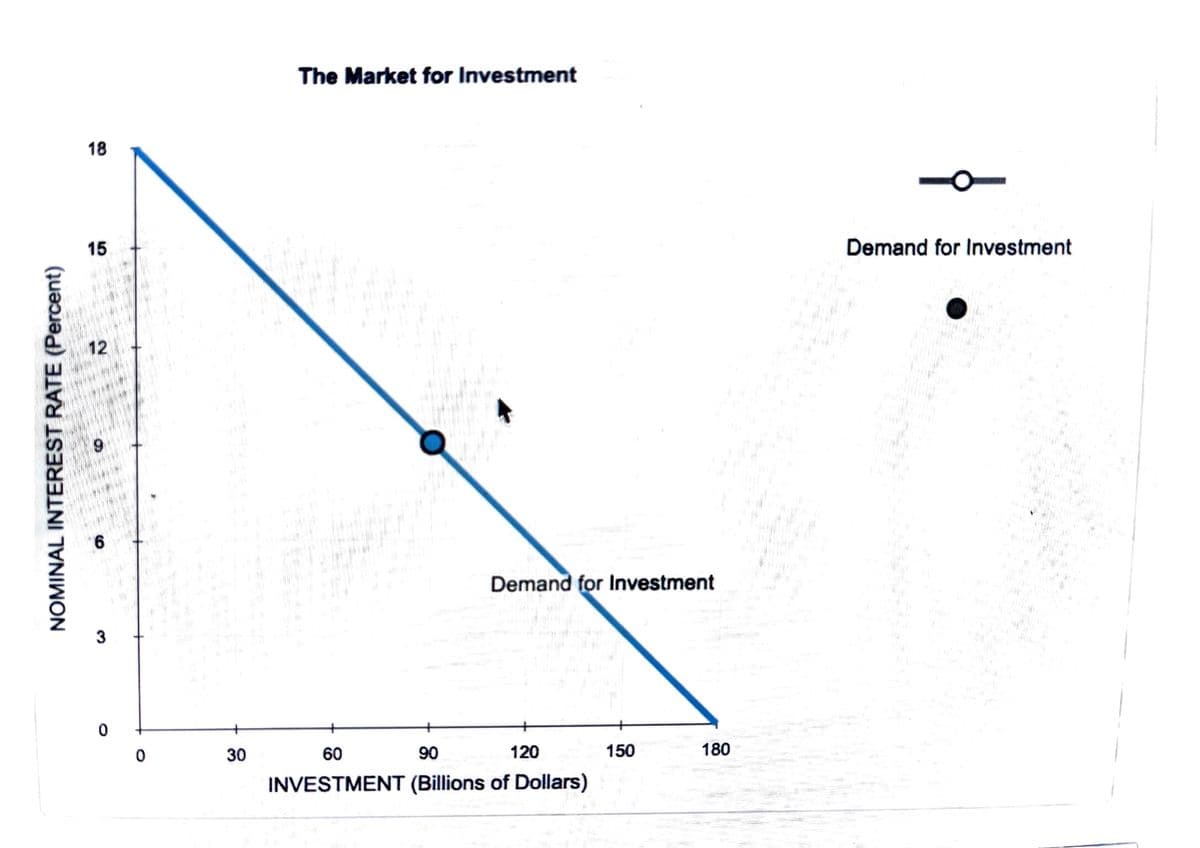Monetary policy and the market for bank reserves Suppose the federal funds rate is not close to zero, risk spreads are roughly constant so that different interest rates rise and fall together, and banks are not holding many excess reserves. Federal Reserve open-market operations are done mostly in Treasury bills. Such economic conditions are referred to as “normal times.” Suppose the Federal Reserve implements an expansionary monetary policy by _________(BUYING /SELLING) bonds through open-market operations. The following graph shows the demand and supply of bank reserves. On the graph, show the effect of the Fed's expansionary monetary policy by shifting one or both of the curves. Note: Select and drag one or both of the curves to the desired position. Curves will snap into position, so if you try to move a curve and it snaps back to its original position, just drags it a little farther. THE FIRST IMAGE IS OF THE FIRST GRAPH As a result of the Fed's expansionary policy, the interest rate______(rises/falls) to _________ 2nd graph Investment is one component of total spending. The following graph shows the demand for investment. Use the information from the previous graph to show the short-run effect of the Fed's expansionary monetary policy by shifting the demand curve or moving the point along the curve on the following graph. Hint: Be sure the new interest rate corresponds to the interest rate you found in the previous graph. 2nd IMAGE IS OF the SECOND GRAPH As a result of the Fed's expansionary policy, the quantity of investment demanded _________(RISES/FALLS) to ________ billion. The following graph shows the aggregate demand (AD) curve in the goods and services market before the Fed implements its expansionary policy. Suppose that the multiplier in this economy is 4. ON The following graph, show the effect of the change in investment demand on the AD curve once the multiplier process has run its course. Use the green curve (triangle symbol) to plot the new AD curve at price levels of 40 and 140. Hint: Use the new quantity of investment demanded you found in the Market for Investment and the multiplier to determine the exact change in aggregate demand at both price levels. Assume that this effect is independent of the price level, that is, the AD curve has a parallel shift. On the following graph, show the effect of the change in investment demand on the AD curve once the multiplier process has run its course. Use the green curve (triangle symbol) to plot the new AD curve at price levels of 40 and 140. Hint: Use the new quantity of investment demanded you found in the Market for Investment and the multiplier to determine the exact change in aggregate demand at both price levels. Assume that this effect is independent of the price level, that is, the AD curve has a parallel shift. An expansionary monetary policy causes the quantity of bank reserves in the economy to ___________(INCREASE/DECREASE), which drives interest rates ______(UP /DOWN) . As a result, businesses invest_______(MORE/LESS) in capital improvements such as new factories and equipment. This leads to _______(AN INCREASE/A DECREASE) in aggregate demand, the extent of which is determined by the simple spending multiplier. NOTE - THIS IS ONE QUESTION BUT IT IS DIVIDED INTO 3 SUBPARTS PLEASE SOLVE ALL 3 SUBPARTS. I AM UNABLE TO ADD THE LAST GRAPH PICTURE
Monetary policy and the market for bank reserves Suppose the federal funds rate is not close to zero, risk spreads are roughly constant so that different interest rates rise and fall together, and banks are not holding many excess reserves. Federal Reserve open-market operations are done mostly in Treasury bills. Such economic conditions are referred to as “normal times.” Suppose the Federal Reserve implements an expansionary monetary policy by _________(BUYING /SELLING) bonds through open-market operations. The following graph shows the demand and supply of bank reserves. On the graph, show the effect of the Fed's expansionary monetary policy by shifting one or both of the curves. Note: Select and drag one or both of the curves to the desired position. Curves will snap into position, so if you try to move a curve and it snaps back to its original position, just drags it a little farther. THE FIRST IMAGE IS OF THE FIRST GRAPH As a result of the Fed's expansionary policy, the interest rate______(rises/falls) to _________ 2nd graph Investment is one component of total spending. The following graph shows the demand for investment. Use the information from the previous graph to show the short-run effect of the Fed's expansionary monetary policy by shifting the demand curve or moving the point along the curve on the following graph. Hint: Be sure the new interest rate corresponds to the interest rate you found in the previous graph. 2nd IMAGE IS OF the SECOND GRAPH As a result of the Fed's expansionary policy, the quantity of investment demanded _________(RISES/FALLS) to ________ billion. The following graph shows the aggregate demand (AD) curve in the goods and services market before the Fed implements its expansionary policy. Suppose that the multiplier in this economy is 4. ON The following graph, show the effect of the change in investment demand on the AD curve once the multiplier process has run its course. Use the green curve (triangle symbol) to plot the new AD curve at price levels of 40 and 140. Hint: Use the new quantity of investment demanded you found in the Market for Investment and the multiplier to determine the exact change in aggregate demand at both price levels. Assume that this effect is independent of the price level, that is, the AD curve has a parallel shift. On the following graph, show the effect of the change in investment demand on the AD curve once the multiplier process has run its course. Use the green curve (triangle symbol) to plot the new AD curve at price levels of 40 and 140. Hint: Use the new quantity of investment demanded you found in the Market for Investment and the multiplier to determine the exact change in aggregate demand at both price levels. Assume that this effect is independent of the price level, that is, the AD curve has a parallel shift. An expansionary monetary policy causes the quantity of bank reserves in the economy to ___________(INCREASE/DECREASE), which drives interest rates ______(UP /DOWN) . As a result, businesses invest_______(MORE/LESS) in capital improvements such as new factories and equipment. This leads to _______(AN INCREASE/A DECREASE) in aggregate demand, the extent of which is determined by the simple spending multiplier. NOTE - THIS IS ONE QUESTION BUT IT IS DIVIDED INTO 3 SUBPARTS PLEASE SOLVE ALL 3 SUBPARTS. I AM UNABLE TO ADD THE LAST GRAPH PICTURE
Chapter12: Money And Banking
Section: Chapter Questions
Problem 10E
Related questions
Question
Monetary policy and the market for bank reserves
Suppose the federal funds rate is not close to zero, risk spreads are roughly constant so that different interest rates rise and fall together, and banks are not holding many excess reserves . Federal Reserve open-market operations are done mostly in Treasury bills. Such economic conditions are referred to as “normal times.”
Suppose the Federal Reserve implements an expansionary monetary policy by _________(BUYING /SELLING) bonds through open-market operations.
The following graph shows the demand and supply of bank reserves.
On the graph, show the effect of the Fed's expansionary monetary policy by shifting one or both of the curves.
Note: Select and drag one or both of the curves to the desired position. Curves will snap into position, so if you try to move a curve and it snaps back to its original position, just drags it a little farther. THE FIRST IMAGE IS OF THE FIRST GRAPH
As a result of the Fed's expansionary policy, the interest rate______(rises/falls) to _________
2nd graph
Investment is one component of total spending. The following graph shows the demand for investment.
Use the information from the previous graph to show the short-run effect of the Fed's expansionary monetary policy by shifting the demand curve or moving the point along the curve on the following graph.
Hint: Be sure the new interest rate corresponds to the interest rate you found in the previous graph.
As a result of the Fed's expansionary policy, the quantity of investment demanded _________(RISES/FALLS) to ________
billion.
The following graph shows the aggregate demand (AD) curve in the goods and services market before the Fed implements its expansionary policy. Suppose that the multiplier in this economy is 4.
ON The following graph, show the effect of the change in investment demand on the AD curve once the multiplier process has run its course. Use the green curve (triangle symbol) to plot the new AD curve at price levels of 40 and 140.
Hint: Use the new quantity of investment demanded you found in the Market for Investment and the multiplier to determine the exact change in aggregate demand at both price levels. Assume that this effect is independent of the price level, that is, the AD curve has a parallel shift.
On the following graph, show the effect of the change in investment demand on the AD curve once the multiplier process has run its course. Use the green curve (triangle symbol) to plot the new AD curve at price levels of 40 and 140.
Hint: Use the new quantity of investment demanded you found in the Market for Investment and the multiplier to determine the exact change in aggregate demand at both price levels. Assume that this effect is independent of the price level, that is, the AD curve has a parallel shift.
An expansionary monetary policy causes the quantity of bank reserves in the economy to ___________(INCREASE/DECREASE), which drives interest rates ______(UP /DOWN) . As a result, businesses invest_______(MORE/LESS) in capital improvements such as new factories and equipment. This leads to _______(AN INCREASE/A DECREASE) in aggregate demand, the extent of which is determined by the simple spending multiplier.
NOTE - THIS IS ONE QUESTION BUT IT IS DIVIDED INTO 3 SUBPARTS PLEASE SOLVE ALL 3 SUBPARTS. I AM UNABLE TO ADD THE LAST GRAPH PICTURE.

Transcribed Image Text:INTEREST RATE (Percent)
18
15
12
9
6
3
0
The Market for Bank Reserves
Supply
Demand
0
300
600
900
1200
1500
QUANTITY OF BANK RESERVES (Billions of Dollars)
1800
Demand
Supply

Transcribed Image Text:NOMINAL INTEREST RATE (Percent)
18
15
12
9
6
3
0
0
30
The Market for Investment
g
Demand for Investment
60
90
120
150
180
INVESTMENT (Billions of Dollars)
Demand for Investment
Expert Solution
This question has been solved!
Explore an expertly crafted, step-by-step solution for a thorough understanding of key concepts.
This is a popular solution!
Trending now
This is a popular solution!
Step by step
Solved in 4 steps with 3 images

Knowledge Booster
Learn more about
Need a deep-dive on the concept behind this application? Look no further. Learn more about this topic, economics and related others by exploring similar questions and additional content below.Recommended textbooks for you

